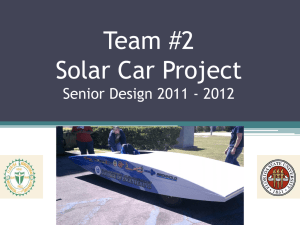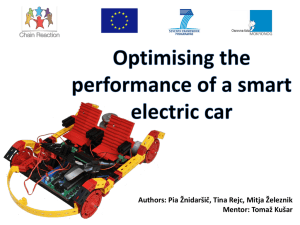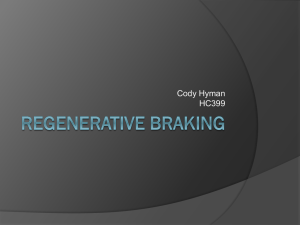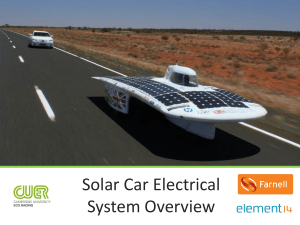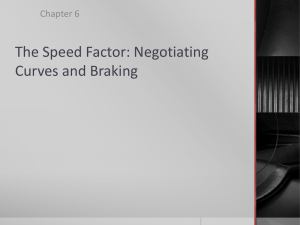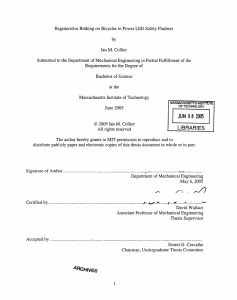MUEV
advertisement
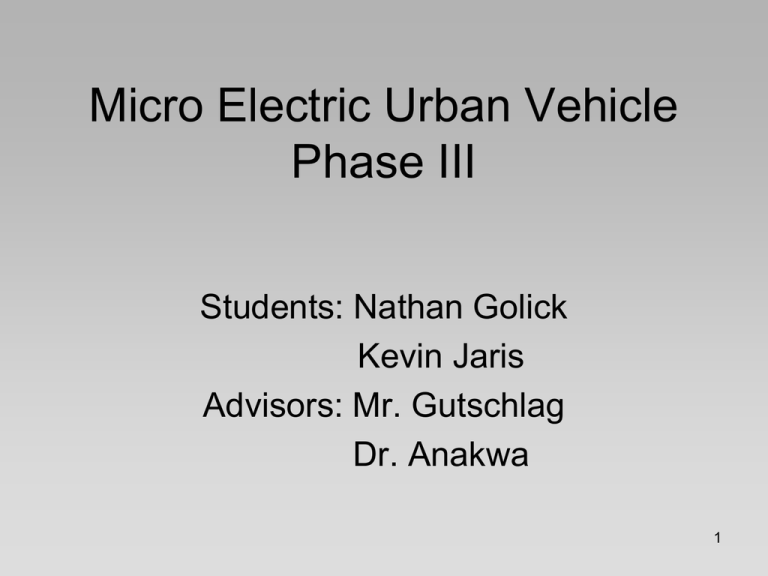
Micro Electric Urban Vehicle Phase III Students: Nathan Golick Kevin Jaris Advisors: Mr. Gutschlag Dr. Anakwa 1 Outline of Presentation • • • • • • • • Project Summary Review of previous work Functional Description Block Diagrams Functional Requirements Performance Specifications Equipment and parts list Schedule of tasks to be completed 2 Project Summary • Create Simulink models for regenerative braking subsystem. • Use additional DC motor to simulate vehicle braking dynamics. • Use power electronics to recover energy provided by the additional DC motor during the simulated braking process. • Investigate the option of implementing a variable speed motor drive. • If time permits integrate completed design on the Miniature Electric Urban Vehicle (MEUV). 3 Review of Previous Work: Phase I • Researched all components of a micro electric vehicle. • Created a drive model. • Selected optimal components for a test platform. • Built a prototype MEUV. 4 Phase I Final Design • Motor – D&D Separately Excited Brushed DC • • • • • • • Model: ES-10E-33 8 HP Continuous 6.7” Diameter 11” Length 56 lbs 7/8” x 2” Shaft 3/16” Keyway 5 Phase I Final Design • Controller – Alltrax DCX600 • 24-48V Battery Input • 600 Amp Limit for 2 minutes • 30 Amp Field Winding Limit • Standby current: < 35mA • Drives motor to 17 peak HP • 18 kHz Operating Frequency • -25 C to 75 C Operating Temperature – 95 C shutdown 6 Phase I Final Design • Battery • Three 12 Volt Lead Acid Batteries • 44 Ah Capacity each • Low Cost 7 Phase I Final Design •Single speed gear reduction drive 8 Review of Previous Work: Phase 2 • Create Simulink Models – Battery – DC Motor – Controller – Vehicle Dynamics – Data Collection (minimal) 9 Project Description • Use an additional DC motor to drive the go-cart motor and use power electronics to recover the kinetic energy during braking simulations. • Use a controlled voltage on the additional motor to simulate various braking profiles applied to the gocart motor. • Model regenerative braking subsystem in Simulink. • Perform multiple simulations to verify the design. • Investigate the possibility of using a variable speed drive to recover energy at lower speeds. • Integrate completed design with the Miniature Electric Urban Vehicle (MEUV). 10 System Block Diagram DC Motor Braking Motor Controller (Voltage Profile) Drive Shaft Coupling Go-Kart Motor Braking Power Electronics Battery Super Capacitors (Optional) Battery Charger Brake Input 11 Functional Requirements • Brake pedal shall apply regenerative braking up to approximately 75% displacement. • Brake pedal shall apply hydraulic and regenerative braking above 75% pedal displacement. • Power electronics shall optimize the recovery of the available kinetic energy. • Batteries and possibly super capacitors shall store all energy recovered by the power electronics. 12 DC – DC Boost Converter Boost Converter Schematics Vo/Vi = 1/(1-D) Boost Converter Idealized Equation 13 Equipment List Vehicle Platform •Make: Vector Go Kart •Model #: 4170 •Brakes: 7.5" hydraulic disc with parking brake •Tires (Front): 16"x6"x8" •Tires (Rear): 16"x7"x8" •Dimensions: 72"L x 46"W x 49"H •Wheel Base : 47.5" •Seat to pedals: 33" to 37" •Curb weight: 310lbs •Max. Rider weight: 300lbs 14 Equipment List Batteries(3) • Product ID: Interstate SLA1161 • Type: Sealed lead acid • Voltage: 12V • Capacity: 44 Ah Controller • Type: Alltrax DCX-600 15 Equipment List Motor (Go Kart) • Type: D&D Separately Excited Brushed 24-48V DC Motor • Model #: ES-10E-33 • Max power: 17HP • Max speed: 3000RPM 16 Equipment List Braking Simulation Motor •Type: Yet to be determined. Voltage Profile Controller •Yet to be determined. 17 Schedule of Future Tasks Date Nate Golick Kevin Jaris Week 1 1/29/2013 Aquire additional motor Simulate power electronics Week 2 2/5/2013 Design pedal displacement system Contruct power electronics Week 3 2/12/2013 Create Simulink model of motor Create voltage profile Week 4 2/19/2013 Test power electronics with additional motor Week 5 2/26/2013 Test power electronics with additional motor Week 6 3/5/2013 Week 7 3/12/2013 Mount both motors onto test platform Week 8 3/26/2013 Test regenerative braking system Week 9 4/2/2013 Test regenerative braking system Week 10 4/9/2013 Test regenerative braking system Week 11 4/16/2013 Mount regenerative braking system to MUEV Week 12 4/23/2013 Test regenerative braking system on MUEV Week 13 4/30/2013 Test regenerative braking system on MUEV Week 14 5/7/2013 Finalize report and presentation Week 15 5/14/2013 Presentation Remove go kart motor from MUEV Create Simulink model of regenerative braking 18 Questions? 19

